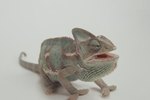
A drastic change in your pet's skin tone is often cause for alarm, but not in the case of the leopard gecko. When he turns gray, he's not getting sick; the change is perfectly normal. As your gecko grows, he sheds. Once you know that your pet isn't in any danger, the process can be fascinating to observe.
About Shedding
When your gecko gets ready to shed, his skin will turn almost a whitish-gray color. It will feel papery to you. The skin will begin to feel loose the closer the reptile gets to shedding. Never attempt to remove the peeling skin from your pet, unless problems occur. Geckos eat their shed skin, so don't remove it from the habitat. The entire body should shed at once, though some areas, such as the toes, can be problematic. Juvenile geckos will shed every three to four weeks as they grow, while adults shed every few months.
How to Help
When you notice your gecko's skin start to turn a whitish-gray, set up a separate shelter to house the gecko in. Leopard geckos prefer dark, moist hiding areas when they shed. The shelter should contain moist peat moss or cypress mulch as bedding. Cover it with a lid that has air holes. When the skin is ready to come off, the gecko will pull away the skin with its mouth and consume it. In most cases, the gecko is able to remove all the skin on his own.
What to Look Out for
Sometimes areas of skin won't come off successfully. Generally, this occurs around the toes. It can constrict blood flow, resulting in the loss of toes. The area usually heals quickly, but it's best to act before the damage is done. Should the gecko lose a toe, you can treat the area with an over-the-counter reptile wound medication. In any case that you feel the reptile's suffering or shedding improperly, make an appointment with the vet.
Removing Leftover Skin
Be gentle when removing leftover skin from the toes. Always soak the gecko in warm water for 30 minutes before attempting to remove the skin. This allows the skin to soften for easier removal. Remove the loosened skin with a pair of tweezers. If the skin still shows resistance, repeat the process of soaking the skin until it becomes softened enough to remove easily. Never force the skin to come loose.
References
- "Leopard Geckos"; Gerold Merker, Cindy Merker, Julie Bergman; 2006
- "The Pet Owners Guide to Geckos"; Matthew Debanks; 2012
Photo Credits
-
Jupiterimages/Photos.com/Getty Images
Writer Bio
Amy Brantley has been a writer since 2006, contributing to numerous online publications. She specializes in business, finance, food, decorating and pets.



